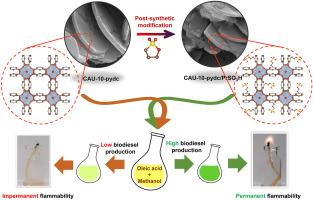Post-synthetic modification of CAU-10-pydc nanosheets with sulfonic acid groups: A robust MOF-based heterogeneous acid catalyst for efficient oleic acid esterification
IF 4.7
3区 材料科学
Q1 CHEMISTRY, APPLIED
引用次数: 0
Abstract
A special class of aluminum-based metal-organic frameworks (MOFs) named as CAU-10-pydc with a unique nanosheet morphology was used for the first time as a solid support to prepare an efficient and novel heterogeneous acid catalyst. This MOF was facilely synthesized through a conventional solvothermal technique, and sulfonic acid groups were post-synthetically introduced to the CAU-10-pydc framework via the nucleophilic interaction of pyridinic N atoms of organic ligand with 1,3-propanesultone and subsequent treatment with sulfuric acid. The successful incorporation of sulfonic acid groups in CAU-10-pydc structure was confirmed using FT-IR, EDX-map, XPS, and N2-sorption analyses, while the modification potential of this MOF was precisely determined using 1H NMR technique. Also, this kind of MOF was found structurally stable during the post-synthetic modification (PSM) process, which was evaluated by XRD and FE-SEM techniques. The catalytic performance of as-prepared CAU-10-pydc/PrSO3H catalyst was evaluated in acid-catalyzed esterification of oleic acid with methanol to produce renewable, ecofriendly, and sulfur-free biodiesel. The high oleic acid conversion of 95.5 % was achieved with sustained combustibility following a short reaction time of 2 h in the presence of CAU-10-pydc/PrSO3H catalyst, while the non-catalytic experiment and unfunctionalized CAU-10-pydc exhibited much lower catalytic activity.

基于磺酸基的CAU-10-pydc纳米片合成后改性:一种高效油酸酯化的mof基多相酸催化剂
本文首次将具有独特纳米片结构的铝基金属有机骨架(mof) cac -10-pydc作为固体载体,制备了一种高效的新型非均相酸催化剂。该MOF通过传统的溶剂热技术很容易地合成,并通过有机配体的吡啶N原子与1,3-丙磺酸的亲核相互作用以及随后的硫酸处理,在CAU-10-pydc框架中引入磺酸基团。通过FT-IR, EDX-map, XPS和n2吸附分析证实了磺酸基团在CAU-10-pydc结构中的成功结合,同时利用1H NMR技术精确确定了该MOF的修饰潜力。在合成后修饰(PSM)过程中,发现这种MOF结构稳定,并通过XRD和FE-SEM技术对其进行了评价。考察了所制备的cac -10-pydc/PrSO3H催化剂在油酸与甲醇酯化反应中的催化性能,以制备可再生、环保、无硫生物柴油。在催化条件下,cac -10-pydc/PrSO3H催化剂在2 h内可实现95.5%的高油酸转化率,而非催化实验和未官能化的cac -10-pydc的催化活性要低得多。
本文章由计算机程序翻译,如有差异,请以英文原文为准。
求助全文
约1分钟内获得全文
求助全文
来源期刊

Microporous and Mesoporous Materials
化学-材料科学:综合
CiteScore
10.70
自引率
5.80%
发文量
649
审稿时长
26 days
期刊介绍:
Microporous and Mesoporous Materials covers novel and significant aspects of porous solids classified as either microporous (pore size up to 2 nm) or mesoporous (pore size 2 to 50 nm). The porosity should have a specific impact on the material properties or application. Typical examples are zeolites and zeolite-like materials, pillared materials, clathrasils and clathrates, carbon molecular sieves, ordered mesoporous materials, organic/inorganic porous hybrid materials, or porous metal oxides. Both natural and synthetic porous materials are within the scope of the journal.
Topics which are particularly of interest include:
All aspects of natural microporous and mesoporous solids
The synthesis of crystalline or amorphous porous materials
The physico-chemical characterization of microporous and mesoporous solids, especially spectroscopic and microscopic
The modification of microporous and mesoporous solids, for example by ion exchange or solid-state reactions
All topics related to diffusion of mobile species in the pores of microporous and mesoporous materials
Adsorption (and other separation techniques) using microporous or mesoporous adsorbents
Catalysis by microporous and mesoporous materials
Host/guest interactions
Theoretical chemistry and modelling of host/guest interactions
All topics related to the application of microporous and mesoporous materials in industrial catalysis, separation technology, environmental protection, electrochemistry, membranes, sensors, optical devices, etc.
 求助内容:
求助内容: 应助结果提醒方式:
应助结果提醒方式:


